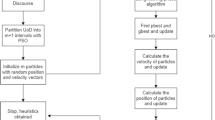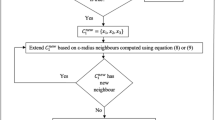Abstract
The fuzzy time series has received extensive attention since it was proposed and it has been widely used in various practical applications. This study proposes a new fuzzy time series forecasting model which considers a hybrid wolf pack algorithm (HWPA) and an ordered weighted averaging (OWA) aggregation operator for fuzzy time series. The HWPA is adopted to obtain a suitable partition of the universe of discourse to promote the forecasting performance. Furthermore, the improved OWA aggregation method is applied to make the aggregation of historical information more practical. To overcome the deficiency of slow convergence speed and easy to entrap into the local extremum of the wolf pack algorithm (WPA), the chemotactic behavior and elimination–dispersal behavior of bacterial foraging optimization (BFO) are employed to optimize the scouting behavior of WPA. The actual enrollments data of the University of Alabama and Taiwan Futures Exchange (TAIFEX) are utilized as the benchmark data and the computational results of both training and testing phases all indicate that the new forecasting model outperforms other existing models. The robustness of the proposed model is also tested and the robust results can be obtained when the historical data are inaccurate.






Similar content being viewed by others
References
Zadeh, L.A.: Fuzzy set. Inform. Control 8(3), 338–353 (1965)
Song, Q., Chissom, B.S.: Forecasting enrollments with fuzzy time series part i. Fuzzy Sets Syst. 54(1), 1–9 (1993a)
Song, Q., Chissom, B.S.: Fuzzy time series and its models. Fuzzy Sets Syst. 54(3), 269–277 (1993b)
Song, Q., Chissom, B.S.: Forecasting enrollments with fuzzy time series part ii. Fuzzy Sets Syst. 62(1), 1–8 (1994)
Chen, S.M.: Forecasting enrollments based on fuzzy time series. Fuzzy Sets Syst. 81(3), 311–319 (1996)
Yu, H.K.: A refined fuzzy time-series model for forecasting. Phys. A Stat. Mech. Appl. 346(3), 657–681 (2005)
Huarng, K.H., Yu, H.K.: Ratio-based lengths of intervals to improve fuzzy time series forecasting. IEEE Trans. Syst. Man Cybern. Part B 36(2), 328–340 (2006)
Cheng, C.H., Chang, J.R., Yeh, C.A.: Entropy-based and trapezoid fuzzificationbased fuzzy time series approaches for forecasting it project cost. Technol. Forecast. Soc. Change 73(5), 524–542 (2006)
Li, S.T., Cheng, Y.C., Lin, S.Y.: A FCM-based deterministic forecasting model for fuzzy time series. Comput. Math. Appl. 56(12), 3052–3063 (2008)
Chi, K., Fu, F.P., Che, W.G.: A novel forecasting model of fuzzy time series based on k-means clustering. Int. Workshop Educ. Technol. Comput. Sci. 1, 223–225 (2010)
Guler, Dincer N., Akkus, O.: A new fuzzy time series model based on robust clustering for forecasting of air pollution. Ecol. Inform. 43, 157–164 (2018)
Zhang, W.Y., Zhang, S.X., Zhang, S.: Two-factor high-order fuzzy-trend FTS model based on BSO-FCM and improved KA for TAIEX stock forecasting. Nonlinear Dyn. 94, 1429–1446 (2018)
Wu, H., Long, H.M., Jiang, J.C.: Handling forecasting problems based on fuzzy time series model and model error learning. Appl. Soft Comput. 78, 109–118 (2019)
Pal, S.S., Kar, S.: Fuzzy time series model for unequal interval length using genetic algorithm. Inform. Technol. Appl. Math. 699, 205–216 (2019a)
Jiang, P., Yang, H.F., Heng, J.N.: A hybrid forecasting system based on fuzzy time series and multi-objective optimization for wind speed forecasting. Appl. Energy 235, 786–801 (2019)
Chen, C.S., Jhong, Y.D., Wu, W.Z., Chen, S.T.: Fuzzy time series for real-time flood forecasting. Stochastic Environ. Res. Risk Assess. 33(3), 645–656 (2019)
Kuo, I.H., Horng, S.J., Kao, T.W., Lin, T.L., Lee, C.L., Pan, Y.: An improved method for forecasting enrollments based on fuzzy time series and particle swarm optimization. Expert Syst. Appl. 36(3), 6108–6117 (2009)
Kuo, I.H., Horng, S.J., Chen, Y.H., Run, R.S., Kao, T.W., Chen, R.J., Lai, J.L., Lin, T.L.: Forecasting TAIFEX based on fuzzy time series and particle swarm optimization. Expert Syst. Appl. 37(2), 1494–1502 (2010)
Huang, Y.L., Horng, S.J., He, M., Fan, P., Kao, T.W., Khan, M.K., Lai, J.L., Kuo, I.H.: A hybrid forecasting model for enrollments based on aggregated fuzzy time series and particle swarm optimization. Expert Syst. Appl. 38(7), 8014–8023 (2011)
Qiu, W., Zhang, C., Ping, Z.: Generalized fuzzy time series forecasting model enhanced with particle swarm optimization. Int. J. u- and e-Serv. Sci. Technol. 8(7), 129–140 (2015)
Uslu, V.R., Bas, E., Yolcu, U., Egrioglu, E.: A fuzzy time series approach based on weights determined by the number of recurrences of fuzzy relations. Swarm Evol. Comput. 15, 19–26 (2014)
Pal, S.S., Kar, S.: Time series forecasting for stock market prediction through data discretization by fuzzistics and rule generation by rough set theory. Math. Comput. Simul. 162, 18–30 (2019b)
Singh, P., Dhiman, G.: A hybrid fuzzy time series forecasting model based on granular computing and bio-inspired optimization approaches. J. Comput. Sci. 27, 370–385 (2018)
Yolcu, U., Cagcag, O., Aladag, C.H., Egrioglu, E.: An enhanced fuzzy time series forecasting method based on artificial bee colony. J. Intell. Fuzzy Syst. 26(6), 2627–2637 (2014)
Zeng, S.Z., Chen, S.M., Teng, M.O.: Fuzzy forecasting based on linear combinations of independent variables, subtractive clustering algorithm and artificial bee colony algorithm. Inform. Sci. 484, 350–366 (2019)
Cai, Q., Zhang, D., Zheng, W., Leung, S.C.H.: A new fuzzy time series forecasting model combined with ant colony optimization and auto-regression. Knowl. Based Syst. 74(1), 61–68 (2015)
Xian, S.D., Zhang, J.F., Xiao, Y., Pang, J.: A novel fuzzy time series forecasting method based on the improved artificial fish swarm optimization algorithm. Soft Comput. 22(12), 3907–3917 (2018)
Garg, B., Garg, R.: Enhanced accuracy of fuzzy time series model using ordered weighted aggregation. Appl. Soft Comput. 48, 265–280 (2016)
Aladag, C.H., Egrioglu, E., Yolcu, U., Uslu, V.R.: A high order seasonal fuzzy time series model and application to international tourism demand of turkey. J. Intell. Fuzzy Syst. Appl. Eng. Technol. 26(1), 295–302 (2014)
Pal, S.S., Kar, S.: Time series forecasting using fuzzy transformation and neural network with back propagation learning. J. Intell. Fuzzy Syst. 33(1), 467–477 (2017)
Pal, S.S., Kar, S.: A hybridized forecasting method based on weight adjustment of neural network using generalized type-2 fuzzy set. J. Intell. Fuzzy Syst. 21, 308–320 (2018)
Wu, H.S., Zhang, F.M., Lu-Shan, W.U.: New swarm intelligence algorithm-wolf pack algorithm. Syst. Eng. Electron. 35(11), 2430–2438 (2013)
Passino, K.M.: Biomimicry of bacterial foraging for distributed optimization and control. IEEE Control Syst. 22(3), 52–67 (2002)
Yager, R.R.: On ordered weighted averaging aggregation operators in multicriteria decision making. IEEE Trans. Syst. Man Cybern. 18(1), 183–190 (1988)
Yager, R.R., Filev, D.: Parameterized and-like and or-like owa operators. Int. J. Gen. Syst. 22(3), 297–316 (1994)
Yager, R.R.: Quantifier guided aggregation using OWA operators. Int. J. Intell. Syst. 11(1), 49–73 (1996)
Yager, R.R.: Time series smoothing and OWA aggregation. IEEE Trans. Fuzzy Syst. 16(4), 994–1007 (2008)
Zadeh, L.A.: A computational approach to fuzzy quantifiers in natural languages. Comput. Math. Appl. 9(1), 149–184 (1983)
Wong, W.K., Bai, E., Chu, W.C.: Adaptive time-variant models for fuzzy-timeseries forecasting. IEEE Trans. Syst. Man Cybern. Part B 40(6), 1531–1542 (2010)
Qiu, W.R., Liu, X.D., Li, H.L.: A generalized method for forecasting based on fuzzy time series. Expert Syst. Appl. 38(8), 10446–10453 (2011)
Wang, J., Chen, K.: Frequency-weighted fuzzy time series model based on time variations. Classics Appl. Math. 11(2), 76–90 (2013)
Lee, C.L., Kuo, S.C., Lin, C.J.: An efficient forecasting model based on an improved fuzzy time series and a modified group search optimizer. Appl. Intell. 46(3), 641–651 (2017)
Hwang, J.R., Chen, S.M., Lee, C.H.: Handling forecasting problems using fuzzy time series. Fuzzy Sets Syst. 100(1–3), 217–228 (1998)
Chen, S.M., Chung, N.Y.: Forecasting enrollments using high-order fuzzy time series and genetic algorithms. Int. J. Intell. Syst. 21(5), 485–501 (2006)
Huarng, K.: Heuristic models of fuzzy time series for forecasting. Fuzzy Sets Syst. 123(3), 369–386 (2001)
Lee, L.W., Wang, L.H., Chen, S.M., Leu, Y.H.: Handling forecasting problems based on two-factors high-order fuzzy time series. IEEE Trans. Fuzzy Syst. 14(3), 468–477 (2006)
Lee, L.W., Wang, L.H., Chen, S.M.: Temperature prediction and TAIFEX forecasting based on high-order fuzzy logical relationships and genetic simulated annealing techniques. Expert Syst. Appl. 34(1), 328–336 (2008)
Acknowledgements
The authors express their gratitude to the Editor and the anonymous Reviewers for their valuable and constructive comments. And this work was supported by the Chongqing Social Science Planning Project (No. 2018YBSH085), Graduate Teaching Reform Research Program of Chongqing Municipal Education Commission (YJG183074), Major entrustment projects of the Chongqing Bureau of quality and technology supervision (CQZJZD2018001), Chongqing research and innovation project of graduate students (CYS18252), and the National Natural Science Foundation of China (No.11671001).
Author information
Authors and Affiliations
Corresponding author
Rights and permissions
About this article
Cite this article
Xian, S., Li, T. & Cheng, Y. A Novel Fuzzy Time Series Forecasting Model Based on the Hybrid Wolf Pack Algorithm and Ordered Weighted Averaging Aggregation Operator. Int. J. Fuzzy Syst. 22, 1832–1850 (2020). https://doi.org/10.1007/s40815-020-00906-w
Received:
Revised:
Accepted:
Published:
Issue Date:
DOI: https://doi.org/10.1007/s40815-020-00906-w




